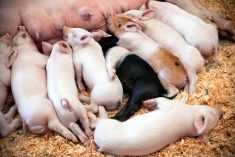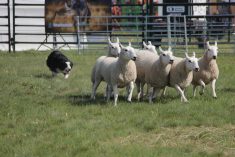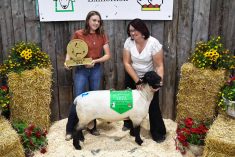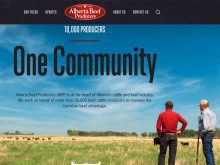Originally grown as a cereal crop, it has received good marks in research trials and impressed livestock producers
The shock and excitement is still noticeable when Micheline Maes of Blackwell Hay Farms just northwest of Cochrane, Alta., talks about the first time she saw the analysis for the farm’s teff hay.
“I was like, this is the Holy Grail,” she said.
“You’re always looking for that combination of low sugar and high protein.”
As a competitive trail rider, Maes brings a passion for equine nutrition to her work but teff, a cereal crop originally from Ethiopia, has a wider appeal beyond the horse community.
A warm-season grass, teff has been tweaked from its original purpose as a grain-producing grass — the seed heads are pounded to make a flour — to a leafier version more suitable for grazing. Early Agriculture Canada trials by Akilu Alemu and Alan Iwaasa in Swift Current, Sask., last year were impressive, even in the midst of drought, according to Bart Lardner from the University of Saskatchewan.
“My whole career I’ve been investigating new forages,” he says.
This one is interesting. It’s got great potential. “
Adds ruminant nutritionist Abby-Ann Redman: “It’s not very common in the industry yet.… Plenty of people in the United States and Australia use it, but the first time I heard of it, I was like, ‘what?’ ”
Teff grows quickly, germinating within four or five days and can be ready for harvest in as few as 45 days. Multiple cuts, even in a fairly short growing season, are possible, and farm owner Rob Blackwell and Maes have an ongoing debate as to whether a “normal” growing season would allow two or three cuts at the farm.
“We’ve never had two cuts,” says Blackwell.
“The protein numbers astonished me.”
In a joint study between the universities of Oregon, Washington and Idaho published in 2018, analysis showed that teff was typically higher in forage quality and protein than most other common forage grasses. As a bonus, it also required less nitrogen fertilizer and was extraordinarily drought tolerant.
“I was amazed at how green it was,” says Maes. “It was like someone came along with a spray paint can.”
Adds Blackwell: “It grew on two inches of rain.”
The experience on Blackwell’s farm is echoed by Lardner.
“In the Swift Current trial, it was used in small plots. For a warm season annual, it did quite nicely and may help with our annual summer slump challenge, when our perennials go high-fibre and stop growing.”
This year it will be used as forage in a grazing study with stock cattle.
Teff is not without challenges, however. Extremely frost sensitive, it must be treated as an annual. Additionally, it is a very fine plant and can be tricky to bale.
“Like silk,” says Maes.
Attention must be paid to the seed bed; it needs to be firm and must be planted very shallow for good germination.
“If you put it too deep, you’ve got trouble,” says Lardner. “It’s not like seeding barley.”
Teff seed is very fine, and a coated seed is often recommended so that standard seed drills can be used. Brillion seeders were recommended in the American joint study, but the Saskatchewan trial is using a 15-foot John Deere no-till seed drill.
On his farm, Blackwell plans to roll, plant and then roll again to ensure adequate contact. The American study indicates a lower total use of nitrogen fertilizer for teff grazing, but Maes points out that for hay, fertilizing with every cut is recommended in order to keep the protein values high.

A potential work around for the fertilizer may be putting in a legume alongside the teff, something Lardner’s colleagues are exploring.
“We’re putting it in with hairy vetch,” he says.
While Blackwell is mostly focused on growing hay for the equine market, his teff has also been bought by sheep and calving operations, attracted by the high protein for late-gestation ruminants.
“It’s a softer grass,” says Redman, “and very palatable and from what I’ve read, the three macrominerals (calcium, magnesium and phosphorus) rate higher than timothy hay.”
She points out there is always variation between stands, and a lot depends on when the teff was cut.
“Always get an analysis. If you don’t measure, you don’t know.”
For producers looking to buy hay, another advantage seems to be that nitrates aren’t a factor, even in drought years.
“If we continue to get these dry years, this could be a great option to stretch your pastures,” says Redman.
Lardner says if farmers don’t get rain in June, they could seed late and still put animals on it in August.
“The big attraction for us is its resistance to extremes,” says Maes, pointing out that teff does well in both very dry and very wet conditions.















